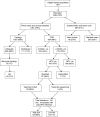Cervical human papillomavirus infection and squamous intraepithelial lesions in rural Gambia, West Africa: viral sequence analysis and epidemiology
- PMID: 16106268
- PMCID: PMC2361674
- DOI: 10.1038/sj.bjc.6602736
Cervical human papillomavirus infection and squamous intraepithelial lesions in rural Gambia, West Africa: viral sequence analysis and epidemiology
Abstract
The development of effective strategies against cervical cancer in Africa requires accurate type specific data on human papillomavirus (HPV) prevalence, including determination of DNA sequences in order to maximise local vaccine efficacy. We have investigated cervical HPV infection and squamous intraepithelial lesions (SIL) in an unselected cohort of 1061 women in a rural Gambian community. Squamous intraepithelial lesions was diagnosed using cytology and histology, HPV was typed by PCR-ELISA of DNA extracts, which were also DNA sequenced. The prevalence of cervical HPV infection was 13% and SIL were observed in 7% of subjects. Human papillomavirus-16 was most prevalent and most strongly associated with SIL. Also common were HPV-18, -33, -58 and, notably, -35. Human papillomavirus DNA sequencing revealed HPV-16 samples to be exclusively African type 1 (Af1). Subjects of the Wolof ethnic group had a lower prevalence of HPV infection while subjects aged 25-44 years had a higher prevalence of cervical precancer than older or younger subjects. This first report of HPV prevalence in an unselected, unscreened rural population confirms high rates of SIL and HPV infection in West Africa. This study has implications for the vaccination of Gambian and other African populations in the prevention of cervical cancer.
Figures
Similar articles
-
Prevalence of specific types of human papillomavirus and cervical squamous intraepithelial lesions in consecutive, previously unscreened, West-African women over 35 years of age.Int J Cancer. 2003 Mar 1;103(6):803-9. doi: 10.1002/ijc.10876. Int J Cancer. 2003. PMID: 12516102
-
Oncogenic human papillomavirus infection and cervical lesions in aboriginal women of Nunavut, Canada.Sex Transm Dis. 2001 Dec;28(12):694-700. doi: 10.1097/00007435-200112000-00006. Sex Transm Dis. 2001. PMID: 11725224
-
Human papilloma virus prevalence, genotype distribution, and pattern of infection in Thai women.Asian Pac J Cancer Prev. 2011;12(4):853-6. Asian Pac J Cancer Prev. 2011. PMID: 21790214
-
Human papillomavirus genotype distribution in low-grade cervical lesions: comparison by geographic region and with cervical cancer.Cancer Epidemiol Biomarkers Prev. 2005 May;14(5):1157-64. doi: 10.1158/1055-9965.EPI-04-0812. Cancer Epidemiol Biomarkers Prev. 2005. PMID: 15894666 Review.
-
[Epidemiology of cervical papillomavirus infections. Recent knowledge].Presse Med. 2001 Jun 9;30(20):1017-23. Presse Med. 2001. PMID: 11433694 Review. French.
Cited by
-
The age-specific prevalence of human papillomavirus and risk of cytologic abnormalities in rural Nigeria: implications for screen-and-treat strategies.Int J Cancer. 2012 May 1;130(9):2111-7. doi: 10.1002/ijc.26211. Epub 2011 Aug 5. Int J Cancer. 2012. PMID: 21630264 Free PMC article.
-
A population-based cross-sectional study of age-specific risk factors for high risk human papillomavirus prevalence in rural Nigeria.Infect Agent Cancer. 2011 Jul 29;6:12. doi: 10.1186/1750-9378-6-12. Infect Agent Cancer. 2011. PMID: 21801395 Free PMC article.
-
Distribution of high- and low-risk human papillomavirus genotypes and their prophylactic vaccination coverage among West African women: systematic review.J Egypt Natl Canc Inst. 2023 Dec 7;35(1):39. doi: 10.1186/s43046-023-00196-x. J Egypt Natl Canc Inst. 2023. PMID: 38060078
-
The spectrum of opportunistic infections and malignancies among women on antiretroviral therapy in Ethiopia.Emerg Microbes Infect. 2023 Dec;12(2):2271065. doi: 10.1080/22221751.2023.2271065. Epub 2023 Oct 27. Emerg Microbes Infect. 2023. PMID: 37824698 Free PMC article.
-
Plasma cytokine levels and human papillomavirus infection at the cervix in rural Nigerian women.Cytokine. 2013 Oct;64(1):146-51. doi: 10.1016/j.cyto.2013.07.028. Epub 2013 Aug 22. Cytokine. 2013. PMID: 23972725 Free PMC article.
References
-
- Astori G, Beltrame A, Pipan C, Raphenon G, Botta GA (1999) PCR-RFLP-detected human papilloma virus infection in a group of Senegalese women attending an STD clinic and identification of a new HPV-68 subtype. Intervirology 42: 221–227 - PubMed
-
- Baay MF, Kjetland EF, Ndhlovu PD, Deschoolmeester V, Mduluza T, Gomo E, Friis H, Midzi N, Gwanzura L, Mason PR, Vermorken JB, Gundersen SG (2004) Human papillomavirus in a rural community in Zimbabwe: the impact of HIV co-infection on HPV genotype distribution. J Med Virol 73: 481–485 - PubMed
-
- Bayo S, Bosch FX, de Sanjose S, Munoz N, Combita AL, Coursaget P, Diaz M, Dolo A, van den Brule AJ, Meijer CJ (2002) Risk factors of invasive cervical cancer in Mali. Int J Epidemiol 31: 202–209 - PubMed



